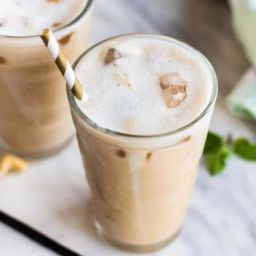
Let’s dive into the world of coffee makers, shall we? There’s a whole universe of them out there, each with its own way of turning those precious beans into the magical brew we can’t seem to live without.
From the simplicity of pour-overs that demand your full, undivided attention to the push-button convenience of drip machines that let you snooze a little longer in the morning, there’s a coffee maker for every type of coffee drinker.
Why fuss about the type of coffee maker, you ask? Well, because not all coffee is created equal—and the right machine can make or break your perfect cuppa.
Imagine using finely ground espresso in a French press. Disaster, right? That’s why matching your coffee type to your coffee maker isn’t just fancy talk; it’s essential for unlocking that dream brew.
Check out the Amazon Fresh, Dark Roast, Whole Bean Coffee on Amazon now!
Types of Coffee Beans
Now, onto the stars of the show: the coffee beans. You’ve probably heard of Arabica and Robusta—the Beyoncé and Jay-Z of coffee beans.
Arabica, with its smooth, sophisticated flavors, tends to steal the spotlight. It’s the bean of choice for those who prefer a coffee that’s more soulful and less in-your-face.
Robusta? It’s the tough guy. Strong, robust (hence the name), and with a caffeine kick that can wake the dead. It’s not as refined as Arabica, but it packs a punch and often comes cheaper.
Why does this matter? Because the type of bean you choose will majorly influence the taste, aroma, and even the texture of your coffee. Arabica’s great for those who love a coffee with character and complexity, while Robusta suits those who crave that bold, powerful hit.
Pour-Over Coffee Makers
Pour-over coffee makers are like the artisanal crafters of the coffee world. Picture this: a sleek, simple setup where you play the role of a barista, meticulously pouring hot water over freshly ground coffee. It’s not just brewing; it’s a ritual.
The pour-over method is all about control—over the water temperature, the pour rate, and the brew time. This means you can tweak each cup to your heart’s content.
Best practices? Start with a medium-fine grind. Too coarse, and your coffee will be under-extracted, tasting more like tea. Too fine, and you’ll be sitting around waiting for the last drip of an over-extracted brew.
As for the beans, Arabica’s nuanced flavors truly shine in a pour-over. Its subtle notes become the frontman, giving you a cup that’s complex and rich with every sip.
Check out the Amazon Fresh, Dark Roast, Whole Bean Coffee on Amazon now!
French Press
Ah, the French press. This is for those who like their coffee with a bit of texture, a bit of body. It’s straightforward: coarsely ground coffee meets hot water, they hang out together for a few minutes, then a press-down plunger separates them, leaving you with a bold and beautiful brew.
What makes it special? This method allows oils and fine particles from the coffee to remain in your cup, adding depth and intensity to the flavor.
For the French press, coarse-ground beans are your best friends. They ensure a clean press and prevent your coffee from turning into a gritty, bitter mess.
The full-bodied flavor you get from this method pairs perfectly with the richness of Arabica beans, making each cup a velvety smooth experience.
Espresso Machines
Espresso machines are the high-pressure, high-intensity performers of the coffee world. They force hot water through finely ground coffee, producing a concentrated shot of pure, caffeinated gold. This method is all about precision: the right temperature, the right pressure, and the right timing.
The coffee type? Fine grind is the way to go. It’s like the espresso machine’s soulmate, creating the perfect resistance for water to extract those deep, rich flavors and that signature crema on top.
Arabica beans, with their complex profiles, elevate the espresso, turning a simple shot into a symphony of taste that dances across your tongue.
In each of these brewing methods, the type of coffee and the grind size play crucial roles in crafting the perfect cup. Whether you’re seeking the ritualistic precision of pour-over, the robust simplicity of a French press, or the intense delight of an espresso, the right combination of coffee maker and coffee type can elevate your brewing game to new heights.
Drip Coffee Makers
Drip coffee makers? Oh, they’re the unsung heroes of the morning rush. Pop in your coffee, pour in the water, hit the button, and bam—you’ve got a pot of coffee that’s ready to tackle the day with you.
It’s all about hitting that sweet spot of convenience without sacrificing too much on the taste front.
For the grind, think middle of the road—medium grind is your golden ticket. It’s just right for allowing the water to extract all those delicious coffee flavors without going overboard.
Plus, it avoids the pitfalls of going too fine (hello, bitter coffee) or too coarse (watery brew, anyone?). And when it comes to beans, a good quality Arabica blend will give you that balanced flavor that sings in a drip coffee setup.
Check out the Amazon Fresh, Dark Roast, Whole Bean Coffee on Amazon now!
Vietnamese Coffee Maker (Phin)
The Vietnamese coffee maker, or Phin, is like a little coffee ninja. It’s compact, no-fuss, and it brews a cup that packs a punch.
This traditional method involves a slow drip that patiently crafts a strong, concentrated coffee. It’s a testament to the beauty of taking things slow, offering a moment of calm before you dive into the chaos of the day.
Robusta beans are the go-to here. They’re bold, they’re strong, and they embody the essence of Vietnamese coffee.
When brewed in a Phin, Robusta beans create a cup that’s rich, a little chocolaty, and definitely not afraid to show off its intensity.
It’s a flavor that can stand up to the traditional sweetened condensed milk add-in, making for a truly iconic coffee experience.
AeroPress
The AeroPress is like the Swiss Army knife of coffee makers—versatile, efficient, and capable of making just about any coffee style you crave. It’s a favorite for coffee enthusiasts who love to experiment.
The AeroPress lets you play around with grind size, brewing time, and pressure to dial in your perfect cup.
Fine grind coffee is your best bet with an AeroPress. It speeds up the extraction process, giving you a rich and flavorful brew without the wait.
This method shines with a high-quality Arabica, bringing out subtle flavors and aromas that might get lost in more forgiving brewing methods.
Whether you’re after an espresso-like shot or a more traditional Americano, the AeroPress has got you covered with its adaptability and ease of use.
Check out the Amazon Fresh, Dark Roast, Whole Bean Coffee on Amazon now!
Stovetop Moka Pot
The Moka Pot is like the old-school, tough-love relative of coffee makers. It’s straightforward but demands respect. You fill the bottom with water, the middle with a medium-coarse grind, screw it tight, and let the stove do its magic.
The pressure forces the water up through the coffee, creating a brew that’s as close to espresso as you can get without the fancy machine.
Why medium-coarse grind? It’s the sweet spot that prevents the pot from clogging while still allowing for a rich extraction.
Plus, it gives you that bold, full-bodied flavor that Moka Pots are famous for. It’s traditional, it’s a bit of an art, and the result is utterly satisfying.
Siphon Coffee Makers
Siphon coffee makers are the mad scientists of the coffee world. They look complicated with their two chambers and burner underneath, but the show they put on is worth it.
You heat the water in the bottom chamber until it rises to mix with the coffee grounds in the top. Then, remove the heat, and the brewed coffee magically siphons back down, leaving the grounds behind.
Medium grind works best here. It strikes the perfect balance between extraction time and flavor, giving you a cup that’s refined, with delicate flavor profiles that might get lost in more brute-force methods. It’s a brew method that’s as much about the spectacle as it is about the taste.
Check out the Amazon Fresh, Dark Roast, Whole Bean Coffee on Amazon now!
FAQs
What grind size should I use for a French press?
Go coarse. It’s all about letting those flavors steep without ending up with a cup full of sediment.
Can I use espresso beans in a drip coffee maker?
Yes, but remember it’s all about the grind size. A medium grind of espresso beans can make for a rich, bold drip coffee.
Is there a difference between beans for espresso and beans for other coffee makers?
Not really. It’s more about the roast and grind size than the bean itself. However, espresso often uses a darker roast to achieve that classic flavor.
How do I choose beans for cold brew?
Cold brew is forgiving. A coarse grind of any medium to dark roast works well, leaning towards the sweeter, chocolaty profiles to complement the smoothness cold brewing brings out.
Can I make espresso in a regular coffee maker?
Not true espresso, but you can make a strong coffee by using a fine grind and less water. It won’t have the crema but can mimic the intensity.
Final thoughts
Choosing the right coffee type for your coffee maker isn’t just about snobbery—it’s about making magic happen in your cup. Whether you’re a pour-over purist, a French press fanatic, or an espresso enthusiast, using the right grind size and bean type is like having the secret code to unlock flavor heaven.
Think of it this way: your coffee maker is a musician, and the coffee type is the instrument. Sure, a talented musician can make any instrument sound good, but give them the right one, and they’ll make it sing. From the bold, robust tunes of a Moka Pot to the delicate melodies of a siphon brewer, each coffee maker has its own song, and the coffee type is key to hitting those perfect notes.
So, what’s the takeaway? Experiment, explore, and don’t be afraid to mix it up. Coffee is personal, and part of the fun is finding your unique blend of brew method and bean. By paying attention to the harmony between your coffee maker and your coffee type, you’ll elevate your coffee game from mere routine to a daily ritual of crafting something truly special.
Read more about the Different Types of Coffee Drinks in this article.









